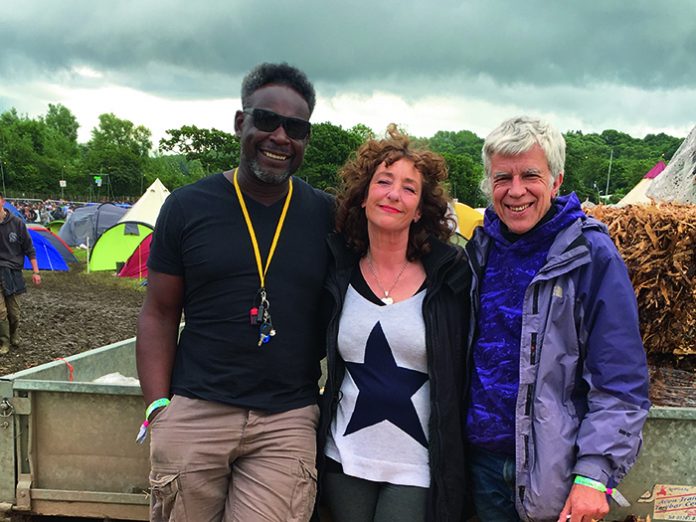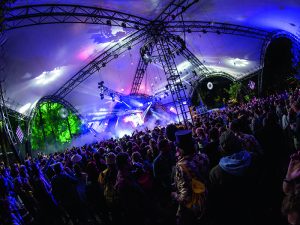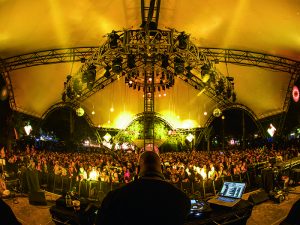Glastonbury 2016 welcomed back the Experimental Soundfield, a place in which new thinking is embraced as the boundaries of sound as we know it are questioned. Funktion One’s Tony Andrews and Acid House DJ, A Guy Called Gerald, speak to TPi’s Kelly Murray about the importance of continually pushing the limits in audio experimentation…
What’s your favourite Glastonbury memory?
Tony: It has to be the first Experimental Soundfield we created in 1992, right on the edge of the festival. That’s when we first did surround sound. At that time we had the old Pink Floyd quadrophonic desk; four speakers in a circle, 100 ft wide. I think there were about 8,000 people in the field and we more or less got banned from the festival that night because we couldn’t stop; it was the only entertainment still going.
Underworld were playing, with Darren Emerson at FOH. We were going for about 14-hours one day. It was our first bit of learning with doing surround sound. The speed of sound is pretty slow, so you’ve got to be careful how you aim speakers, we learnt that here. We also learnt that if you’ve got four speakers about 100 yards apart, if you stand near one particular speaker, you can’t hear the other speakers. When you’re doing it in a small room, you don’t run into those sorts of problems, but you do in a field. We called it the Experimental Soundfield because it was, and it actually still is experimental.
How does the term ‘experimental sound’ alter your work now?
Gerald: I’m a bass freak and this project is the ultimate bass experience. Because the sound is experimental, you can take it frequency-wise to wherever you want within the boundaries of the mix. You can go really low. You’ve got a sub and an ‘under the ground’ feel here, like Tony said, that’s really hard to achieve in an outside venue. It’s a dream!
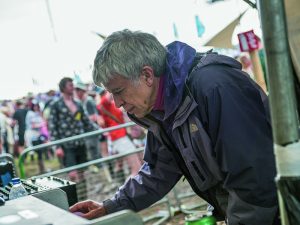
Does that influence what and how you perform, as a DJ?
Gerald: I try to go for material that’s energetic but not too full. If it’s too busy, you don’t hear the movement of what’s going on. I have to think about that when I’m playing. It’s all live mixing – it’s like working from a mixing desk, with separate parts.”
Tony: That’s a really important point, the way Gerald works. He’s not bound to beat matching. For everything we’ve done together with this project, he’s at the FOH position so that he can hear everything. He’s working on the whole rig rather than on a set of monitors. What he’s hearing is what everyone else hears. And that was always the idea of the Experimental Soundfield; I don’t like that separation. There’s a whole different sound on-stage compared to what the audience is hearing. It would be of great benefit if more DJs and performers ventured out front to listen to what the audience is hearing.
Gerald: The lower the frequency the more omnipresent it is and the higher the frequency, the more directional it is, so it’s much easier to move the higher frequencies around. If you’re in a building, you’ve got distortion coming from all over the place that cancels out directivity of the thing that you’re hearing. Whereas, when you’re in a field, the sound disappears into the ether…
Tony: It’s a much purer sound.
Gerald: It’s a lovely way to work actually. It’s like mixing in the best studio, with the most isolation.
In terms of sound mixing, how does the new Formula Sound / Funktion One DJ mixer benefit your set?
Gerald: I’ve used a few different mixers in my time. I’ve been chopping and changing through mixers because it’s really hard to find a good one, especially nowadays. The focus doesn’t tend to be on the sound itself but on the features and special effects it has. I’m coming more from the synth angle, working with drum machines and the like, so it’s really hard to find something dynamic that I can work with. A lot of the sounds are all compressed and you really have to be able to steer them and control them – it’s like handling the unpredictabilty of a wild horse.
I used the Formular Sound / Funktion One FF6.2 DJ Mixer [six channel, analogue] for the first time yesterday. It was really nice to think ‘the bass is coming in on this track’, nudge it just a little and hear it while everything else was going through. That’s not a typical experience for a DJ mixer. You get that with a mixing console – that knowing kind of control – but not on a DJ mixer. It’s was very smooth as well, really dynamic. I want to go back and use it again and again!
How has the Glade crowd reacted?
Tony: Right from the off, we – Mike Igglesden and I – got to do a two-hour DJ set. I decided to only play the music that has meant something to me over the last 50 years. There was no particular order to it, just what followed. So we were mixing up Frankie Knuckles and Butterfly! The thing I think did it for people was playing Voodoo Chile by Jimi Hendrix. I wouldn’t say I’ve remastered it, because that’s too fancy a description, but let’s just say I’ve re-EQed everything because back in the ‘60s bass wasn’t as important as it is today. No, actually, it always has been important, we just didn’t know it was there. So the last thing I played was Voodoo Chile, the 15-minute one off Electric Ladyland, and people were just absolutely knocked out. That song really does lend itself to gentle movements; as he hits the guitar it just glides across. I had a lot of fun!
People were dancing their nuts off at times but then I put on You’ve Gotta Serve Somebody by Bob Dylan, it’s not one of his better known tracks, but it’s really cool, and the lyrics are amazing. I’m really pleased we did that set.
How is the whole system performing?
Tony: I’ve never heard bass like we did from the DJs last night. I’ve never been totally satisfied by the way it works though; as soon as you get two stacks of bass up, you get reinforcement dead centre, then you go off centre and it cancels, then when you get to it, it’s back on again! You get what you call ‘lobes’. When you’ve got a sine wave, if the peaks are matching the peaks then it’s a reinforcement but at certain positions you get a trough cancelling a peak, so you get a hole. What a lot of sound designers tend to do is put all of the bass along the front with great big gaps in it but then you don’t get any control vertically because it’s too low. And, yeah all right, it kind of works, but we’re looking for that definite single sound, a firmness. Not this ‘woah, woah’ sound. That isn’t a note – it’s a low frequency hum.
I’m calling what we’re doing ‘split-layering the bass’. You keep single sources by splitting the bass into two, with sub-sub on one side and ordinary bass on the other. They go over the top of each other, and they don’t do the same frequencies at all. So, for example, you do 25-45Hz on one side and then 45-90Hz on the other. That way you’ve only got one source. People in the audience get both things together, there’s no conflict. It’s amazing. This has been the first time we’ve been able to try it out.
We’ve known the Glade team for quite a while now and we’ve naturally become friends. When they asked us back here, it meant them allowing me to do what I like to do, which is generally along the lines of ‘let’s see what happens if we take this out’, and I really appreciate it. In some ways, I’m a production manager’s worst nightmare because I’m always experimenting. But if I’m not always experimenting, then I’m retiring. If you don’t experiment, you don’t find out what could happen next…
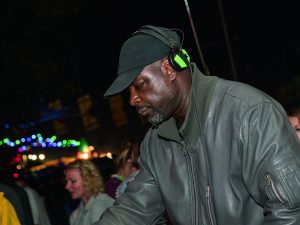
What does the future of ‘good sound’ hold then?
Gerald: Somebody needs to push things forward. Because we tend to think that this is the information age and that must mean that we already know everything there is to know about music production, people seem to be content, even down to tempos. When I started out in the late ‘80s, it was all about trying to move things further or push the sound. We’d do anything and everything to try and personalise sound. That spirit is still here but with a much more formulaic approach. I suppose there’s more money in what used to be the underground scene… It’s crossed over. The reason it existed in the first place was because it allowed you to experiment and I try to encourage that spirit all the time, especially with the next generation just starting out.
Tony: You’re never going to go forward or find anything new if you’re playing safe, which the pro audio business does to a fault. It’s almost become stagnant. It started with the 32-inch bass bin. It’s got about half a tonne of push, which brings all sorts of new mechanical considerations into play that we hadn’t fully appreciated. When we were at Ultra Miami [on the Carl Cox stage], we had eight of them and we figured out they would cover the whole thing. By and large, they did. We put them all on one side and on the other side, we put a few F221’s because I thought there might be a bit of a gap on that side. So I put some 21’s there to cover that area. What we came to realise was that they worked together. The F132’s are very good at doing serious low energy sound, like 30Hz and below, but that actually worked against them for normal bass frequencies. To cut a long story short, I realised that by using the F132’s and F221’s together, we could split the bass, avoid any cancellations and have a very effective solution.
We’ve made our own cone and horn-loaded it, and last night I got the vindication for going down that route. We were getting transient at that kind of frequency. You cannot describe it, it was a new sound. That’s why I’m raving about it! I got a new experience last night at Glade and that’s a precious thing. It was a good, new experience. A lot of people don’t realise the truth and power of audio. To too many people, it’s like choosing what colour you’re going to paint the wall.
Gerald: If I go into a club and it’s really full-on, I come out with my ears ringing. I feel like I’ve paid to get inside but in return they’ve abused my hearing! It seems to be more and more common – in far too many venues.
Tony: There are some big players in pro audio that do everything by numbers. Firstly, it’s of great arrogance to assume we’ve already got of all of the numbers. How do you know that you know all there is to know? They’re selling these ideas to the next generation of engineers; they’re not teaching people how to listen, how to really feel what a sound should be. When I’m responsible for sound, no matter, where I am, at Space or at Glastonbury, if I hear something that makes me feel uncomfortable, I pull it down.
I got into this industry because audio lifted my mind out of where it was and put it in a new place. It inspired me. It’s 50 years later and I’m still driven by that thought.
A lot of people doing audio today might have really clever computers, but where’s their emotion? Where’s their idea of what it means to really feel good sound? The Experimental Soundfield makes me feel so good that I want to share it with everyone.
Photos: Phaze Photography
www.glastonburyfestivals.co.uk
www.funktion-one.com
www.guycalledgerald.com


